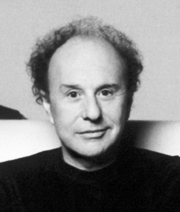Jorge Pensi
Buenos Aires, 1946
Jorge Pensi was born in Buenos Aires, where he studied architecture and started designing and manufacturing his own pieces of furniture. In 1977, he settled in Barcelona and created the design consultancy Grup Berenguer, together with Alberto Lievore, Norberto Chaves, and Oriol Pibernat.
Until 1984, Pensi worked with his compatriot Lievore, they had an integral conception of design: they developed a technical capacity thanks to which they took on the whole life cycle of the product, from the conception of the project to the production strategy, the graphic image or the publicity....
Jorge Pensi was born in Buenos Aires, where he studied architecture and started designing and manufacturing his own pieces of furniture. In 1977, he settled in Barcelona and created the design consultancy Grup Berenguer, together with Alberto Lievore, Norberto Chaves, and Oriol Pibernat.
Until 1984, Pensi worked with his compatriot Lievore, they had an integral conception of design: they developed a technical capacity thanks to which they took on the whole life cycle of the product, from the conception of the project to the production strategy, the graphic image or the publicity. Some of their works were, for example, the furniture for Perobell or Kron, sober pieces of furniture.
In the late 80 s, and on his own, Pensi started to investigate on what would become his most outstanding experience: the potential expressivity of melt and polished aluminum. Some of his works have already become classic pieces of current Spanish design: the Toledo chair of 1988, that redefined sculpturally the traditional metallic terrace café chair, and won many awards; the Regina lamp (1987), Delta de Plata ADI FAD in 1988; and the Olympia lamp (1988), or the Glassbox tables (1995). Refering to this last element, Pensi said: "The concept of poetry is present from the beginning. An example I consider poetic is when Santa & Cole asked us to light the Glassbox glass cabinet, and we chose to do the contrary of what was usual: we put the light outside it is a piece of furniture that was conceived as a poetic object from its origins."
Many of his pieces have been privileged with the immediate appreciation of consumers, for their appearance and functionality, and have been unanimously acknowledged in the world of design and by the international press. His designs are conceived from a deep knowledge of business logic, and come out of a rigorous work method: there is first a conceptual phase in which the product is analyzed, then a creative development phase to provide the object with a poetic dimension, and finally comes the control of the industrial process". An excellent communication is the only way to assure being able to offer an excellent product. The emotions and demands that already arise when talking to the costumer. It is then that the moral duty to make an extraordinary work arises. A kind of energy that makes you find the way of not disappointing emerges then."
In 1997 he was awarded the Spanish National Design Award for his professional career. In his own words: One achieves maturity when you can allow yourself a bit of relax and things come out better. With the possibility of getting wrong and being able to change before it is too late. Now, if we are not absolutely sure we do not go on, we come back and change. We get things less wrong.Santa & Cole has recently published a book on his professional and vital cycle, in parallel with five other Argentine designers in Barcelona (Carlos Rolando, Alberto Lievore, Ricardo Rousselot, Mario Eskenazi and America Sanchez), called Six Argentine designers from Barcelona, and written by Norberto Chaves.
